
Warner Bros. Entertainment Inc. (WBEI), commonly known as Warner Bros. (WB), is an American filmed entertainment studio headquartered at the Warner Bros. Studios complex in Burbank, California, and is the flagship subsidiary of Warner Bros. Discovery (WBD). Founded on April 4, 1923 by four brothers, Harry, Albert, Sam and Jack Warner, the company established itself as a leader in the American film industry before diversifying into animation, television, and video game. It is one of the "Big Five" major American film studios and a member of the Motion Picture Association (MPA).

Burbank is a city in the southeastern end of the San Fernando Valley in Los Angeles County, California, United States. Located 7 miles (11 km) northwest of downtown Los Angeles, Burbank has a population of 107,337. The city was named after David Burbank, who established a sheep ranch there in 1867. Burbank consists of two distinct areas: a downtown/foothill section, in the foothills of the Verdugo Mountains, and the flatland section.

The Walt Disney Studios, located in Burbank, California, United States, serves as the corporate headquarters for The Walt Disney Company. The 51-acre studio lot also contains several sound stages, a backlot, and other filmmaking production facilities for Walt Disney Studios's motion picture production. The complex also houses the offices for many of the company's units, including the film studios Walt Disney Pictures, Walt Disney Animation Studios, and Marvel Studios.

Warner Bros. Studios Leavesden is an 80 ha (200-acre) studio complex in Leavesden in Watford, Hertfordshire, in the East of England. Formerly known as Leavesden Film Studios and still colloquially known as Leavesden Studios or simply Leavesden, it is a film and media complex owned by Warner Bros. The studios were all converted from an aircraft factory and airfield called Leavesden Aerodrome, a centre of British aircraft production during World War II. The nearest railway station is King's Langley which is a walking distance of 1.3 miles (2.1 km).

Warner Bros. Animation Inc. is an American animation studio which is part of the Warner Bros. Television Group, a division of Warner Bros., which is a subsidiary of Warner Bros. Discovery and serves as the animation division and label of Warner Bros.

Location shooting is the shooting of a film or television production in a real-world setting rather than a sound stage or backlot. The location may be interior or exterior.
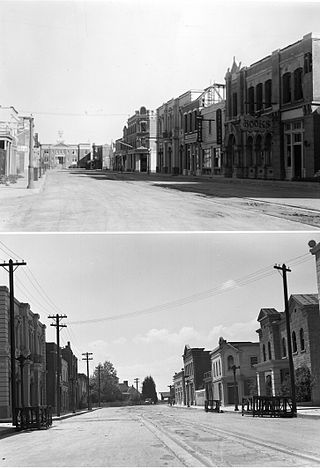
A set is artificially constructed scenery used in film and television. In the last two cases there are many reasons to build or use a set instead of travelling to a real location, such as budget, time, the need to control the environment, or the fact that the place does not exist. Sets are normally constructed on a film studio backlot or sound stage, but any place that has been modified to give the feel of another place is a set.

The Sony Pictures Studios is an American television and film studio complex located in Culver City, California at 10202 West Washington Boulevard and bounded by Culver Boulevard (south), Washington Boulevard (north), Overland Avenue (west) and Madison Avenue (east). Founded in 1912, the facility is currently owned by Sony Pictures and houses the division's film studios, such as Columbia Pictures, TriStar Pictures, and Screen Gems. The complex was the original home of Metro-Goldwyn-Mayer from 1924 to 1986 and Lorimar-Telepictures from 1986 to 1988.
A movie ranch is a ranch that is at least partially dedicated for use as a set in the creation and production of motion pictures and television shows. These were developed in the United States in southern California, because of the climate.

Golden Oak Ranch is an 890-acre (360-hectare) movie ranch owned by the Walt Disney Studios subsidiary of The Walt Disney Company that serves as a filming location and backlot. The ranch is off of Placerita Canyon Road outside of Newhall, Santa Clarita, California, less than an hour north of Los Angeles; its entrance is not far from Placerita Canyon Road's intersection with California State Route 14.
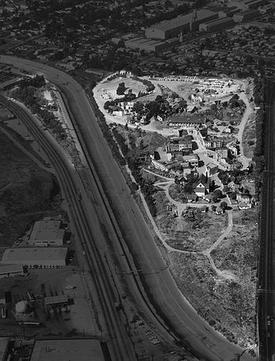
RKO Forty Acres was a film studio backlot in the United States, owned by RKO Pictures, located in Culver City, California. Best known as Forty Acres and "the back forty," it was also called "Desilu Culver," the "RKO backlot," and "Pathé 40 Acre Ranch," depending on which studio owned the property at the time. For nearly 50 years it was known for its outdoor full-scale sets, such as Western Street, Atlanta Street, and Main Street and was used in many films and television series.
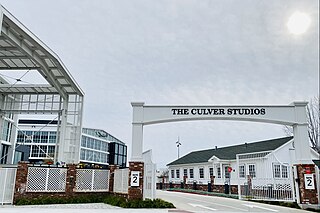
The Culver Studios is a film studio in Culver City, California. Originally created by silent movie pioneer Thomas H. Ince, classics from Hollywood's Golden Age were filmed there. It was purchased, in 2014, by Hackman Capital Partners, which completely modernized the lot over the next four years, while preserving the site's historic structures. The studios have operated under a multitude of names: Ince Studio (1918-1925), De Mille Studios (1925–1928), Pathé Studios (1928–1931), RKO-Pathé Studios (1931–1935), Selznick International Pictures (1935–1956), Desilu-Culver Studios (1956–1970), Culver City Studios (1970–1977), and Laird International Studios (1977–1986).

Sunset Gower Studios is a 14-acre (57,000 m2) television and movie studio at the corner of Sunset Boulevard and North Gower Street in the Hollywood neighborhood of Los Angeles, California, United States. Established in 1912, it continues today as Hollywood's largest independent studio and an active facility for television and film production on its twelve soundstages.

The Old Warner Brothers Studio, now known as the Sunset Bronson Studios, is a motion picture, radio and television production facility located on Sunset Boulevard in Hollywood, Los Angeles, California. The studio was the site where the first talking feature film, The Jazz Singer, was filmed in 1927.

A film studio is a major entertainment company that makes films. Today, they are mostly financing and distribution entities. Additionally, they may also have their own privately owned studio facility or facilities; however, most firms in the entertainment industry have never owned their own studios, but have rented space from other companies. The day-to-day filming operations are generally handled by their production company subsidiary.

The Warner Bros. Ranch is a movie ranch located at 411 North Hollywood Way in Burbank, California. Opened in the 1930s, it was used as the backdrop for films and television shows by Columbia Pictures and Warner Bros.
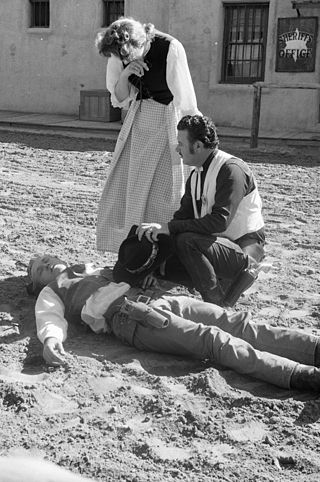
Corriganville Movie Ranch was a working film studio and movie ranch for outdoor location shooting, as well as a Western-themed tourist attraction. The ranch, owned by actor and stuntman Ray "Crash" Corrigan, was located in the foothills of the Santa Susana Mountains in the Santa Susana Pass area of Simi Valley in eastern Ventura County, California. It was destroyed by wildfires in 1970 and 1979. The site is currently a public park in the City of Simi Valley, called Corriganville Park, and operated by Rancho Simi Recreation and Park District.
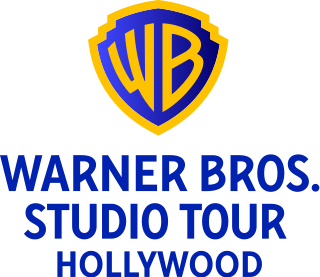
Warner Bros. Studio Tour Hollywood is a guided walk-through tour of Warner Bros. Studios Burbank, located in Los Angeles, California. Over a two-to-three-hour period, visitors can glimpse behind the scenes of one of the oldest film studios in the world.

Warner Bros. Studio Tours are a pair of public attractions owned and run by Warner Bros. Entertainment Inc.

Warner Bros. Studios Burbank, formerly known as First National Studio (1926–1929), Warner Bros.-Seven Arts Studios (1967–1970) and The Burbank Studios (1972–1990), is a major filmmaking facility owned and run by Warner Bros. Entertainment Inc. in Burbank, California, United States. First National Pictures built the 62-acre (25 ha) studio lot in 1926 as it expanded from a film distributor to film production.




















